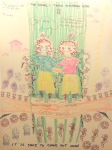As a clown, it is important to abide in my ♡ while I am clowning, but I would like to actually live letting my ♡ lead all the time.
One of the exercises I do to keep getting used to the joy of living in my ♡ , versus the seriousness of letting my mind run things, is the experience of drawing with my non-dominant hand. Around 1989, I started drawing “solutions” to problems that way. I am still completely amazed at how serious and judgmental I am when drawing with my right hand, or what is called from my left brain. When I take the magic markers in my left hand using my right brain the pictures are joyful, uplifting, and playful!
I realized that this drawing with the non-dominant hand exercise would be useful group work. In the book “Chronic illness and the 12 Steps” by Martha Cleveland, (Chapter 7), there is a meditation in which you ask a picture, symbol, or feeling to appear before you that represents a blockage or a trauma in your life. Take time to become familiar with this energy.
Addressing this energy now before you, you ask:
1. “What are you afraid of?” (record the answer),
2. “What do you need from me?” (record the answer),
3. “What do you have to offer me?” (record the answer),
4. “What is your strength? (record the answer).

090491 Meeting aspects of myself. Read More
It is amazing how one can get answers about what gift the energy is hiding from the third and fourth answers, and what to bring forth into the light.
Then we would each draw, with the non-dominant hand, an image of the experience, so that our inner child could come back to the healing experience. It is important to give yourself a lot of time to draw, because that time spent on drawing is focusing on the solution, the energy of wellness, and every stroke line and color is strengthening in your body, emotions, and mind the happiness of receiving that gift.
To learn of the different ways to do the left-handed drawings click here.
To return to the “How To Page with links”, click to return.
If you arrived here via “The Gift of the Wounded Child” page, click to return.
